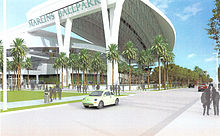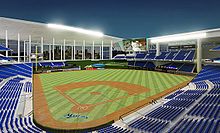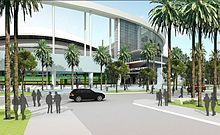- New Marlins Ballpark
-
Marlins Ballpark Marlins Ballpark
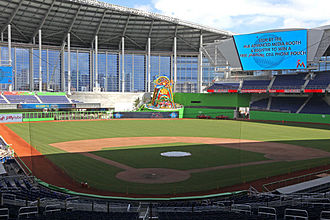
Exterior rendering of Marlins Ballpark with roof openLocation 501 Marlins Way, Miami, Florida 33125 Coordinates 25°46′41″N 80°13′11″W / 25.77806°N 80.21972°WCoordinates: 25°46′41″N 80°13′11″W / 25.77806°N 80.21972°W Broke ground July 1, 2009 (Start of construction preparations)
July 18, 2009 (Ceremonial Groundbreaking)[1]Opened March 5th, 2012 (HS baseball game)
April 1st, 2012 (exhibition game)
April 4th, 2012 (regular season)Owner Miami-Dade County Operator Miami Marlins Surface Bermuda Grass Construction cost US$515 million Architect Populous[2] Project Manager International Facilities Group[3] Structural engineer Bliss and Nyitray, Inc. (bowl and track)
Walter P Moore (roof)General Contractor Hunt/Moss Joint Venture Main contractors MARS Contractors Inc.[4] Capacity 37,000 (approx.)[5] Field dimensions Left Field Line – 340 feet (104 m)
Left-Center Power Alley – 384 feet (117 m)
"Bermuda Triangle" In Left-Center – 420 feet (128 m)
Center Field – 416 feet (127 m)
Right-Center Power Alley – 392 feet (119 m)
Right Field Line – 335 feet (102 m)
Backstop: – 47 ft (14.3 m)Tenants Miami Marlins (MLB) (2012–) Marlins Ballpark is a baseball park currently under construction in Miami, Florida. Upon completion it will become the new home of the Miami Marlins Major League Baseball team.[6] It is being constructed on the site of the former Miami Orange Bowl in Little Havana, about 2 miles (3.2 km) west of Downtown.
Construction is scheduled for completion March 2012, in time for the 2012 Major League Baseball season. The stadium will be the sixth MLB stadium to have a retractable roof. With a planned seating capacity of 37,000, it will be the third-smallest stadium in Major League Baseball by official capacity, and the smallest by actual capacity. The Marlins are scheduled to host two exhibition games at the new ballpark against the New York Yankees on April 1 and 2, 2012,[7] before they play their first regular season game on April 4, 2012. The Marlins are pushing to have the new ballpark host the 2013 World Baseball Classic Championship game and 2015 Major League Baseball All-Star Game.[8]
Contents
History
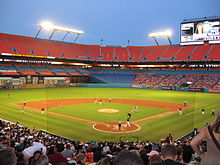 Sun Life Stadium (current name) was home to the Marlins since its inception into Major League Baseball in 1993 until 2011.
Sun Life Stadium (current name) was home to the Marlins since its inception into Major League Baseball in 1993 until 2011.
Planning
Since the inception of the Florida Marlins in April 1993, the team played its home games at the facility currently named Sun Life Stadium. A multi-purpose stadium originally built for football, Sun Life is also the home of the National Football League's Miami Dolphins as well as the Miami Hurricanes college football team. When the stadium was built in 1987, it was designed from the ground up to accommodate baseball and soccer. Dolphins founder Joe Robbie believed it was a foregone conclusion that MLB would come to South Florida, so he wanted the stadium designed to make any necessary renovations for baseball as seamless as possible. Even so, the sight lines for baseball leave much to be desired. Many of the seats in the upper deck are so far away that the Marlins don't even sell them during the regular season. This problem was showcased during the Marlins' two World Series runs in 1997 and 2003. Some portions of left and center field are not part of the football playing field, and fans sitting in the left-field upper deck seats couldn't see the action in those areas except on the replay boards.
Ever since original owner Wayne Huizenga sold the team, the Marlins have been fighting to build their own park.
At the end of the 1990s, then-owner John W. Henry unveiled his vision for a new baseball-only venue. The plan included a retractable roof, believed by this time to be essential due to Miami's intense heat and humidity (Sun Life Stadium is the second-hottest stadium in the majors), as well as its frequent rain. During that time, several plans were developed on where a new ballpark should be built. After the Marlins won the World Series in 2003, both team management and Miami-Dade County officials announced plans to fund a new ballpark. Soon after, the city decided not to help the team pay for a new stadium. However, in January 2004, the City of Miami proposed building a baseball-only stadium for the Marlins at the site of the Miami Orange Bowl that would adjoin the existing football stadium along its northern flank.
Struggles and possible relocation
In May 2004, Miami-Dade County commissioners agreed to fund its portion of a new stadium. The Miami Dolphins notified the Marlins in December 2004 that they would terminate its lease at Sun Life Stadium following the 2010 season if no stadium deal appeared imminent.
One of the biggest steps in the Marlins getting a new ballpark came in February 2005 when Miami-Dade County officials unveiled a financial plan for a $420–$435 million ballpark and parking garage for the Florida Marlins east of the Miami Orange Bowl. However, in May 2005, the Marlins' struggles with the Florida House Legislation continued, as its funding requests of $45 million for a new ballpark were rejected.
In November 2005, the Marlins' negotiations with the City of Miami officially broke down. The failure to work out a stadium deal caused the Marlins to undergo its second fire sale in franchise history, or as the Marlins called it, Market Correction. They ended up trading away Carlos Delgado, Mike Lowell, Josh Beckett, Luis Castillo, and Juan Pierre following the 2005 season. In the end, the Marlins remained committed to remaining in Miami, but also explored other possible options for re-location should no stadium deal be worked out.
In 2006, the Marlins turned down an offer from San Antonio, Texas officials to approve a funding vote for a new stadium to be built there. Instead, there were new signs of hope by Florida Governor Charlie Crist and Hialeah Mayor Julio Robaina. After exploring other options at the former site of the Miami Arena and in Hialeah, the Miami Hurricanes announced they were leaving the Orange Bowl, paving the way for the stadium to be built there.
Financing and lawsuit
In December 2007, the Miami-Dade County Commission voted in favor of two proposals that would assist in funding. City and County Commissioners voted on February 21, 2008 to approve funding for a new ballpark for the Marlins. The total cost is expected to be approximately $515 million. The proposal called for the Marlins to contribute $155 million, Miami-Dade County to contribute $347 million (about $297 million of which would come from tourist tax dollars), and the City of Miami to contribute $13 million.
Construction of the new stadium was, for a time, put on hold because of a lawsuit filed by auto dealer Norman Braman, the former owner of the Philadelphia Eagles. However, on November 21, 2008, Circuit Judge Jeri Beth Cohen signed an order that said that a voter referendum was not required for the 37,000-seat stadium's financing plan. That decision was the final remaining charge of Braman's original seven arguments, and Judge Cohen ruled in favor of the Marlins in all of them.
The Marlins hoped to have had final approval on the stadium on February 13, 2009, but were blindsided by an unexpected, last-minute bid by Commissioner Marc Sarnoff to secure a series of financial concessions from the two-time World Series champions. The Marlins were left in a 2–2 tie in the city commission, but stadium supporter Commissioner Michelle Spence-Jones was on maternity leave and was not there to vote.[9]
On March 19, 2009, Miami commissioners approved building the new stadium in a 3–2 vote. Those supporting the stadium deal were Joe Sanchez, Angel Gonzalez and Michelle Spence-Jones. Against the deal were Marc Sarnoff and Tomás Regalado. Also approved, by a 4–1 vote, was a bid waiver for a private contractor to work around the facility. A super majority was required for the bid waiver, and Sarnoff joined the majority. The final issue before the commission, dealing with an inter-local agreement, passed unanimously. With approval by the county, the team would change its name to the Miami Marlins.[10]
Despite the success of the Florida Marlins in court, the initial plan to have the 37,000-seat retractable-roof stadium ready for Opening Day 2011 was pushed back. Construction began in July 2009 and the new ballpark is expected to be ready for Opening Day 2012.[11]
On March 23, 2009, after more than nine hours of debate, Miami-Dade County commissioners answered the Florida Marlins' 15-year quest for a permanent home by agreeing to bankroll a big share of a $634 million stadium complex to rise on the grounds of the old Orange Bowl site. The vote was 9–4. Voting in favor of the stadium were Commissioners Dennis Moss, Bruno Barreiro, Audrey Edmonson, Natacha Seijas, Javier Souto, Barbara Jordan, Dorrin Rolle, Jose Pepe Diaz and Rebeca Sosa. Also, by a 10–3 vote, commissioners approved a bid waiver for the stadium's construction manager. The votes drew applause in the chamber. The Marlins hope to begin play on Opening Day 2012, under a new name: the Miami Marlins.[12][13]
On April 1, 2009, Miami's planning board voted 6–1 to approve the overall construction permit for the Marlins' new ballpark.[14] MLB president Bob DuPuy said the ballpark will get an All-Star Game within a few years of its opening. The Marlins will apply for the 2013 World Baseball Classic finals.
In the early hours of July 1, 2009, Miami-Dade County commissioners cast the final vote on a set of last-minute changes that cleared the way for the sale of more than $300 million in bonds to pay for construction of a new baseball stadium in Little Havana. The last minute changes were due to the fact that the sale of bonds to pay for a new baseball fell short of expectations on Wall Street the day before, prompting a scramble at County Hall and the last-minute pledge by the Florida Marlins to cover the funding difference. The idea was to raise $306 million on Monday and Tuesday by issuing bonds backed by tourist taxes but it was off by $6.2 million. fetching a higher-than-expected interest rate, thereby reducing the proceeds to the county.
Design
The Marlins announced that the new stadium will retain some of the features that Sun Life Stadium currently has, especially the outfield dimensions. The deepest part of the new ballpark will be 420 feet (130 m) from home plate, and then it will slant down to 416 feet (127 m) in straight-away center field. The "power alley" in right-center will be 392 feet (119 m). The shortest dimension will be 335 feet (102 m) down the right-field line. The vast area in the "power alley" in left-center at Sun Life Stadium, also known as "The Bermuda Triangle", will also transfer to the new stadium. At FanFest in 2009, team President David Samson announced that the shallow left field and deep right field at Dolphin Stadium will be flip-flopped at the new ballpark.
Still uncertain is the actual height of the wall, although it will definitely vary. Sun Life Stadium currently has what was known as the "Teal Tower" or "Teal Monster" at 26.5 feet (8.1 m) in left field, while the rest of the wall is set at 8 feet (2.4 m). In addition, there will be a party suite for fans to have the ability to look out at the field from behind the outfield fence.[15]
When an updated rendering of Marlins Ballpark showed generic blue seats, a group of fans started an online petition to have the seats changed to teal. The fans known as "Project Teal" are trying to make Marlin Ballpark unique to the Marlins after 16 years playing at Sun Life Stadium. Their goal is to have Marlin Teal as recognizable as Dodger Blue and Cardinal Red. As of now, Marlin President David Samson has dismissed the idea of teal seats.
Borrowing pages from current ballparks, the Marlins will have a pool area in left field (Chase Field in Phoenix and FirstEnergy Stadium in Reading, PA) and a porch in right field (Rangers Ballpark in Arlington; it will pay tribute to the porch at old Tiger Stadium in Detroit, but instead of hovering over the playing field, it will be set back into the stands).[16] Left field will also feature an operable glass wall that will slide across and open to a view of Downtown Miami, similar to the retractable roof of Houston's Minute Maid Park.
Stretching the length of four football fields, the plaza surrounding the ballpark will be the largest of any stadium in the history of the United States and feature entertainment, President David Samson said. Taste of Miami food courts will offer croquetas, sushi and stone crabs. Former Miami Mayor Manny Diaz said a hotel, restaurants and retail stores likely will be built around the ballpark; City Manager Pete Hernandez originally said that an ESPN Zone restaurant was a possibility, but the closure of all but two of the sports themed facilities in June 2010 will render this redundant.[17]
The retractable roof is expected to open in approximately 14 minutes 30 seconds and will consist of 8,300 tons of steel, which is the exact weight of the Eiffel Tower. The temperature in the new ballpark will average a comfortable 75 °F (24 °C) with the roof closed. The new ballpark could also be the first retractable roof ballpark to be Silver Certified by Leadership in Energy and Environmental Design (LEED).[18]
The main entrance of the ballpark will be on the side of the West Plaza, and that street will now be known as Marlins Way, which runs along N.W. 16th Ave. Orange Bowl Way merges in with N.W. 14th Ave., Felo Ramirez Dr. is part of N.W. 6th St., and Bobby Maduro Dr. runs along N.W. 4th St.
Features
Marlins owner Jeffrey Loria, a noted art collector, has commissioned several works of art for around the stadium.
Retractable Roof and Outfield Glass Panels: The Marlins will cover the retractable roof with a white membrane because “we want to make sure we’re not absorbing heat in the roof,” said Claude Delorme, the Marlins’ executive vice president/ballpark development. The Marlins expect for the retractable roof to be closed for about 70 of the 81 home games and likely to remain open on some nights in April, when the weather isn’t too hot. It takes 13 to 14 minutes to open the roof, and seven to eight minutes to open the transparent outfield panels that offer a view of the Miami skyline. The six panels are a combined 240 feet long and 60 feet high.[19]
Home Run Feature: Dead center field is expected to have a home run feature akin to Citi Field's Home Run Apple but different in design and feel. The piece, designed by Red Grooms, will be located behind the outfield wall, partially visible during a game. It is expected to be between 50 feet (15 m) to 60 feet (18 m) tall, with bright pink, blue, aqua, and orange colors along with many moving parts. The art feature will rise from a pool of Grooms-designed water and dotted with clouds, pelicans and seagulls. Marlins will jump and laser lights will shine. The home run feature is budgeted at $2.5 million and included in the $515 million cost of the 37,000-seat retractable roof ballpark under construction.[20] Fan reaction to the home run display has been overwhelmingly negative, with a majority of people calling it "tacky."[21]
Aquatic Home Plate Backstop: The Marlins announced that dual aquariums that will serve as a home-plate backstop. They will be built on each side of home plate and will be positioned to prevent any disruption to players on the field. The aquarium to the right of home plate (when looking from the pitcher's mound) will measure 34 feet (10 m) long, 36 inches (91 cm) high and holds over 600 US gallons (2,300 l) of seawater, while the aquarium to the left, will be 24 feet (7.3 m) in length, holding 450 US gallons (1,700 l) of water. Each aquarium will be constructed using a durable fiberglass structure; while crystal-clear acrylic panels 1.5 inches (3.8 cm) thick will be used for the viewing windows that run the entire length of the aquariums. To safeguard the exhibits from impacts, Lexan will be installed in front and in back of the acrylic panels to protect the aquarium from foul balls, errant pitches or any other unexpected contact.[22]
Swimming Pool: A swimming pool on the left field side will be available for purchase, by groups, on a per-game basis.
Entrance/Plaza Paving: Pop artist Carlos Cruz-Diez was selected for his paving design in the west entrance plaza of the stadium.[23]
Commemorative Marker: Daniel Arsham/Snarkitecture were commissioned to design a work to commemorate the former Miami Orange Bowl, which was demolished to make way for the new stadium. The piece uses the letters from the original "Miami Orange Bowl" sign as the basis for the 10-foot-tall (3.0 m) orange concrete letters rearranged across the east plaza so that they form new words as visitors move around them.[24]
Column Illumination: Daniel Arsham/Snarkitecture were also selected for the lighting of the four super columns which support the retractable roof. The lighting is designed to give the illusion of the columns being concealed and revealed through programmable LED lights that fade up and down the columns in subtly shifting patterns, evoking the rhythm of a human breath.[23]
Financing
- Miami Marlins – $155 million
- Miami-Dade County – $347 million
- City of Miami – $13 million
Total Cost: $515 million
Not included were the extra $10 million that went toward the demolition of the Orange Bowl stadium, the site preparation outside of the construction budget, as well as the parking garage.
The total cost is: $2.4 billion, spread over 40 years, to repay $409 million in bonds that will primarily, though not exclusively, cover stadium construction. Roughly $100 million will refinance existing bond debt and another $9 million goes into a debt service reserve fund. The result is $300 million for stadium construction, financed in two ways. One portion, underwritten by Merrill Lynch totaling $220 million, has an interest rate of 6.4 percent and requires immediate repayment. In October 2010 the county must pay $9.6 million, though there are questions over whether tourist taxes will meet that. Annual payments run through 2049 and climb as high as $71 million per year.
The second portion, underwritten by JP Morgan, is for $91 million, $80 million of that for construction. That carries an 8.17 rate, but repayment doesn't begin until 2025.
Yet that grace period comes with a big price: $83 million a year for three years starting in 2038. Then, starting in 2041, six years of payments totaling $118 million annually. Total cost to retire the debt: $1.2 billion.[25]
Comparison to Sun Life Stadium
Characteristic Sun Life Stadium* Marlins Stadium Opening Day April 5, 1993 April 4, 2012 Capacity 75,192 (Baseball 38,560**) 37,000 (approx.) Lower Bowl Seats 21,000 21,500 Legends Level Seats 10,000 4,500 Vista Level Seats 37,500 10,000 Outfield Seats 22,000 4,700 Standing Room 0 1,000 Luxury Suites 240 suites (88 during MLB configuration); 1 mega-suite 50 suites (including 2 mega-suites) Project site area 160 acres (stadium); 280 total acres*** 21 acres (85,000 m2) Retractable roof No (open air) Yes Climate controlled No (outdoors) Yes Average game time temperature 85 ° 75 ° Surface Grass Grass Marlins dugout First Base Side Third Base Side Backstop 58 feet (17.7 m)47 feet (14.3 m)Left Field 330 feet (100.6 m) 340 feet (103.6 m) Left Center 361 feet (110.0 m) 384 feet (117.0 m) Center Field 404 feet (123.1 m) 416 feet (126.8 m) Right Center 375 feet (114.3 m) 392 feet (119.5 m) Right Field 345 feet (105.2 m) 335 feet (102.1 m) Sources: The Miami Marlins - *Controlled by Dolphins
- **As of 2008; Expandable to more than 67,000 during MLB playoffs.
- ***Includes parking lot and surrounding area
Construction gallery
Relative location
- Miami
- Downtown Miami
- Little Havana
- Miami Orange Bowl
- Florida
See also
- Upcoming Major League Baseball stadiums
References
- ^ "Marlins to break ground for new ballpark". http://florida.marlins.mlb.com/news/article.jsp?ymd=20090608&content_id=5206556&vkey=news_fla&fext=.jsp&c_id=fla.
- ^ . http://portfolio.populous.com/projects/marlinsballpark.html.
- ^ http://www.ifgroup.cc/content/?section=506§ion2=590§ion3=592&page=592
- ^ http://www.marscontractors.com/projects.html
- ^ www.worldstadiums.com
- ^ http://www.miamitodaynews.com/news/070524/story7.shtml
- ^ http://florida.marlins.mlb.com/news/article.jsp?ymd=20110802&content_id=22654112&vkey=news_fla&c_id=fla
- ^ http://florida.marlins.mlb.com/news/article.jsp?ymd=20100216&content_id=8079192&vkey=news_fla&fext=.jsp&c_id=fla
- ^ http://www.miamiherald.com/486/story/903725.html
- ^ http://www.miamiherald.com/news/breaking-news/story/957815.html
- ^ New Marlins stadium to open in 2012 MLB.com
- ^ http://www.miamiherald.com/1460/story/964462.html
- ^ http://www.miamiherald.com/sports/baseball/florida-marlins/story/968151.html
- ^ "Miami planning board approves Marlins ballpark permit". April 2, 2009. http://www.bizjournals.com/southflorida/stories/2009/03/30/daily57.html.
- ^ Officially released data
- ^ http://florida.marlins.mlb.com/news/article.jsp?ymd=20090511&content_id=4675082&vkey=news_fla&fext=.jsp&c_id=fla
- ^ http://www.miamiherald.com/sports/story/966030.html
- ^ http://florida.marlins.mlb.com/fla/ballpark/index.jsp
- ^ http://www.miamiherald.com/2011/07/24/2328090/marlins-new-stadium-brings-jobs.html#ixzz1T8xYsjbG
- ^ http://www.sun-sentinel.com/sports/florida-marlins/fl-marlins-1216-20091215,0,2974369.story
- ^ http://www.miamiherald.com/2011/10/07/2444040/artist-rendering-of-marlins-sculpture.html
- ^ http://mlb.mlb.com/news/article.jsp?ymd=20100610&content_id=11025480&vkey=news_mlb&fext=.jsp&c_id=mlb
- ^ a b Joe Frisaro (December 18, 2009). "Marlins select artists for new ballpark". MLB Advanced Media, L.P.. http://florida.marlins.mlb.com/news/article.jsp?ymd=20091218&content_id=7828988&vkey=news_fla&fext=.jsp&c_id=fla. Retrieved December 18, 2009.
- ^ Janie Campbell. "Ballpark's Public Tribute to Daytona Beach Approved". NBC Universal, Inc.. http://www.nbcmiami.com/news/sports/Marlins-Home-Run-Feature-to-Feature-Lasers-79545612.html. Retrieved December 21, 2009.
- ^ http://www.miamiherald.com/457/story/1131885.html
External links
- Florida Marlins Official Homepage
- Live Webcams of Marlins' new ballpark construction
- Moss & Associates, construction manager of the Marlins Ballpark
- Hunt/Moss Joint Venture for Marlins Ballpark Construction
- New Marlins Ballpark on Twitter
Preceded by
Sun Life StadiumHome of the
Miami Marlins
2012–Succeeded by
FutureMiami Marlins The Franchise Seasons • History • Expansion • Expansion Draft • Records • No-hitters • Award winners and league leaders • Players • Owners and executives • Managers • Broadcasters • Miami Marlins Radio Network • Opening Day startersBallparks Sun Life Stadium • New Marlins Ballpark (future)
Spring Training: Cocoa Expo Stadium • Space Coast Stadium • Roger Dean StadiumCulture Rivalries Retired Numbers Key Personnel Owner: Jeffrey Loria • Team President: David Samson • President of Baseball Operations: Larry Beinfest • General Manager: Michael Hill • Manager: Ozzie GuillénWorld Series Championships (2) National League Pennants (2) Division Titles National League East: noneWild Card Berths Minor League Affiliates AAA: New Orleans Zephyrs AA: Jacksonville Suns A: Jupiter Hammerheads • Greensboro Grasshoppers • Jamestown Jammers Rookie: Gulf Coast League Marlins • DSL MarlinsSeasons (19) 1990s-2000s 2010s 2010 • 2011 • 2012Current ballparks in Major League Baseball American League EastCentralWestNational League EastCentralWestCategories:- Event venues established in 2012
- Major League Baseball venues
- Sports venues in Miami, Florida
- Miami Marlins stadiums
- Orange Bowl
- Stadiums under construction in the United States
- Retractable-roof stadiums
- Baseball venues in Florida
Wikimedia Foundation. 2010.



